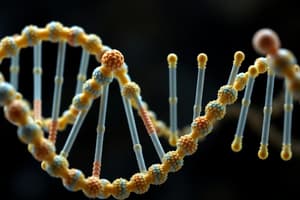Podcast
Questions and Answers
What did Erwin Chargaff establish about the nitrogenous bases in DNA?
What did Erwin Chargaff establish about the nitrogenous bases in DNA?
- The number of purines is always less than pyrimidines.
- The number of purines is always more than pyrimidines.
- The number of pyrimidines is always less than purines.
- The number of purines equals the number of pyrimidines. (correct)
Which technique did Rosalind Franklin and Maurice Wilkins use to analyze the structure of DNA?
Which technique did Rosalind Franklin and Maurice Wilkins use to analyze the structure of DNA?
- Nuclear magnetic resonance
- Electron microscopy
- Chromatography
- X-ray scattering (correct)
What did the X-ray scattering patterns of DNA suggest about its structure?
What did the X-ray scattering patterns of DNA suggest about its structure?
- It was a random coil.
- It had a planar structure.
- It was linear in shape.
- It was helical in nature. (correct)
Why did Watson and Crick arrange the two DNA strands with the sugar-phosphate backbones on the outside and the bases on the inside?
Why did Watson and Crick arrange the two DNA strands with the sugar-phosphate backbones on the outside and the bases on the inside?
What was the significance of the 1962 Nobel Prize in Physiology or Medicine awarded to Watson, Crick, and Wilkins?
What was the significance of the 1962 Nobel Prize in Physiology or Medicine awarded to Watson, Crick, and Wilkins?
What did the repeating distances in X-ray scattering patterns imply about DNA molecules?
What did the repeating distances in X-ray scattering patterns imply about DNA molecules?
What is one of the fundamental characteristics that organisms share?
What is one of the fundamental characteristics that organisms share?
What did Robert Hooke coin the term 'cells' for?
What did Robert Hooke coin the term 'cells' for?
Which of the following is not mentioned as one of the five fundamental characteristics of organisms in the text?
Which of the following is not mentioned as one of the five fundamental characteristics of organisms in the text?
What is one goal that almost everything an organism does contributes to, according to Francois Jacob?
What is one goal that almost everything an organism does contributes to, according to Francois Jacob?
Which famous biologist is quoted in the text with the statement about the 'dream of a bacterium'?
Which famous biologist is quoted in the text with the statement about the 'dream of a bacterium'?
What did Robert Hooke devise in 1665 to examine the structure of cork?
What did Robert Hooke devise in 1665 to examine the structure of cork?
What is the main difference between RNA and DNA molecules?
What is the main difference between RNA and DNA molecules?
What discovery led Sidney Altman and Thomas Cech to share the 1989 Nobel Prize in Chemistry?
What discovery led Sidney Altman and Thomas Cech to share the 1989 Nobel Prize in Chemistry?
Which statement best describes the Tertiary Structure Tetrahymena Ribozyme?
Which statement best describes the Tertiary Structure Tetrahymena Ribozyme?
How does the relationship between ribozymes and proteins suggest the order of events in chemical evolution?
How does the relationship between ribozymes and proteins suggest the order of events in chemical evolution?
What aspect of chemical evolution do random changes in nucleic acids lead to?
What aspect of chemical evolution do random changes in nucleic acids lead to?
What selective advantage allowed for the evolution of new functions during chemical evolution?
What selective advantage allowed for the evolution of new functions during chemical evolution?
Flashcards are hidden until you start studying




